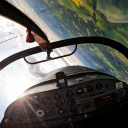
-
Content Count
1,473 -
Donations
$0.00 -
Joined
-
Last visited
Community Reputation
1,729 ExcellentAbout SAS443
- Currently Viewing Forum: Microsoft Flight Simulator (2020)
-
Rank
Member - 1,000+
Profile Information
-
Gender
Male
Flight Sim Profile
-
Commercial Member
No
-
Online Flight Organization Membership
VATSIM
-
Virtual Airlines
No
-
I'm just guessing here. But speaking from experience, most GA pilots would expect a conventional pattern departure of you. That is either straight forward or 45 degrees out. Anytime you deviate from that, you better announce it (blind transmits) clearly on the radios Personally, I'd be pretty upset if I had to solve a near miss situation as I approach the pattern because you decided to leave the area in an unconventional manner.
-
read the local publications what the procedures are when field is uncontrolled the general purpose is to minimize time in the pattern if you intend to leave, thus the solution below is an extremely bad idea. 3. Don't over complicate a basic VFR departure. Just putting the first waypoint further out would simplify things alot. Some pointers I typically use when departing uncontrolled airfield: never fly near the pattern at pattern altitude or 500ft above it... if I absolutely need to make a course change and fly over the airfield I just departed, I usually go atleast 3.000ft above field elevation
-
Thank you Ryan. With your background, your opinion and thoughts are as valuable as they get. Form what I've seen so far, the amount of hiccups and odd vectors (aswell as the invasive UI), this product is not suitable for me nor my style of flying - which is probably similar to yours. Smaller GA often with YFR/ZFR flightplans
-
ICAO clearly states to not interpret it that way. "Pilot-interpreted Approaches (eg ILS) Phraseology The phrase ‘cleared ILS approach runway xx’ has, in the past, introduced some ambiguity whereby pilots have taken this to mean they are cleared to the altitude/height depicted on the approach chart immediately prior to the final approach fix. This should not be assumed; normally clearances to descend at this point will be given distinctly. " //ICAO Standard Phraseology, A Quick Reference Guide for Commercial Air Transport Pilots.
-
All winds are subject to bending via the coriolis force. Or else the winds / clouds would just travel in straight line in the direction to where the local low is. But earth rotates and low pressure weather systems are rotating counter clockwise (in northern Hemisphere) but I these systems are quite large in area and I gather it's not really notable by the human eye. However from satellite images this becomes very apparent. * In meteorology there are actually 3 forces in action around a Pressure system. Pressure gradient force (which acts straight from HP to LP. Coriolis Force Centrifugal force So it's not as easy as a straight line when it comes to winds (and clouds). But then again, can you actually observe this from the ground?
-

Best flight model after A2A ?
SAS443 replied to Aglos77's topic in Microsoft Flight Simulator (2020)
Wow. I don't understand why they let those things slip by (unless it is intentional, but doesn't sound like it?). Correct spin recovery for most planes are just a google search away. I've done spins in the CAP10. Such an agile plane with a big rudder. 65degree turns felt like a normal turn, it just sliced its way through the banks like a tuna fish in water. Really an eye opening experience coming from the usual GA planes. -
Check a satellite image. It will reveal quite clearly which image is more accurate. Satellite from Windy is favoring passive mode by a huge margin. There are absolutely no CU clouds nearby. This is again the reason why AS active mode is not ideal for flights between rural areas where metar info is scarce Edit: noted the snapshot time of 0030z, I thought weather was more current than so. Take my comment with grain of salt then 😄
-
You have to consider that meteoblue NEMS, ICON and ECMWF etc are forecast models. They forecast macro/mesoscale weather and for those purposes they are extremely well refined. They are not good at predicting microscale events such as wind directions disturbed by mechanical turbulence or other local terrain events (including isolated local thunderstorm) ECMWF model found in Windy (which I think is superior) while still great, reports surface wind at my local airport consistently wrong by at least 40 degrees, and have been like that for the last 5 years. It's just too local weather phenomena happening. But again, for VFR (and IFR) flying planning purposes, cloud bases and winds aloft, these models are very competent. They just aren't suitable for minute operative variables used for takeoff, approach and landing decisions. For that you need local observations at the aerodrome. And it will always be like that.
-
IMHO, AS had serious issues with Tru Sky early on. I rarely got accurate ceilings when METAR reported low cloud bases (BKN/OVC) not to mention the square cloud patterns. To be fair, the product improved after that.
-

JF PA-38 Tomahawk coming with A2A-style features
SAS443 replied to F737MAX's topic in Microsoft Flight Simulator (2020)
Short answer, no. Longer answer below, sorry for wall of text (pasted from https://www.pilotmall.com/blogs/news/piper-tomahawk-pa-38-everything-you-need-to-know ) "An unfortunate saga in the Tomahawk’s story is the controversy surrounding its wings. Following a March 1994 dual fatality Tomahawk crash, the NTSB investigation revealed that there were “--reports of significant differences in the stall characteristics between the certification-tested airplane and the production airplanes.” They also discovered that the certification flight testing report did not show any record of turning flight stalls with extended flaps or accelerated stalls with both flap configurations ever having been tested. After checking the records, the NTSB found that the certification testing was all done on a single pre-production aircraft and that multiple test pilots agreed that production Tomahawks were “nothing like the article certified as far as stall characteristics are concerned.” A Piper engineer testified that “--shortly after delivery of production airplanes began, owners and operators of the airplane complained that the lateral directional characteristics at the stall were abrupt and unpredictable, and that the airplane exhibited a rapid roll as the stall occurred.” Piper responded in 1979 by modifying the wing to add two additional stall strips to the existing two stall strips. This modification resulted in the issuance of AD 83-14-08, however apparently the FAA was not involved in any of the testing of the new modifications. According to the NTSB report, a Swedish National Aeronautics Board Investigation Commission conducted their own study after a 1979 stall/spin training accident fatality and they concluded that the Tomahawk “--did not meet the 14 CFR Part 23 certification requirements for wings-level stall characteristics.” This outcome was the same for both the two-stall strip and the four-stall strip configurations." Something just wasn't right how testing was conducted. Never flown a PA38, all aerobatics is in a CAP10. -
Great comparison. ASFS weather is much better in the video, IMHO. But hmm the turbulence effects are terribad in both scenarios. Too snappy/jolty. and barely any yawing tendency at all. Looks extremely fabricated and not realistic (more so with MSFS weather, but still). The Sting weighs what, 600kg? based off my own experience flying the similar sized planes, they get pushed around, in every axis
-
That's where I stand as well. I love Active Sky as a product line. And I think it's great that it is available for MSFS. I recall my first hifisim purchase was back in 2005. Since then plenty of iterations has passed by in my sims (AS evolution, AS2012, AS next, AS2016...I also own Active Sky for XP) But for my style of flying in MSFS which is mostly VFR in largely remote swedish terrain, Meteoblue model is close to the forecasted VFR-areas (vis +5km and BKN/OVC layer +1000ft AGL) published by our local authority. But for other styles of simming I can see ASFS has its audience. Options are never a bad thing.
-
ICAO Annex 3 has been adopted into EU law since many years back. It doesn't merit a discussion at all. It's very clear cut what CAVOK is, but also what's omitted when a station reports CAVOK. Below is CAVOK conditions. For example.
-
CAVOK doesn't mean zero clouds. You can have OVC060 measured (but omitted in the human made observation) and still have CAVOK conditions, it's all in compliance with ICAO Annex 3. Assuming blue skies and validating that assumption against ASFS (or any wx addon for that matter) based on "CAVOK" is inconclusive.
-

New Fenix Download, A319/A321 info and flash sale
SAS443 replied to Matchstick's topic in Microsoft Flight Simulator (2020)
You already have. It's the LS push button.







